Your store's lighting makes products look dull, leading to lost sales. COB LED downlights can transform this, creating an inviting space that highlights merchandise and boosts revenue.
COB LED downlights improve the customer experience with focused, high-quality light that shows true product colors. This creates a welcoming atmosphere, highlights items effectively, and guides shoppers through the store. This simple change can increase customer engagement and sales for any retail chain.
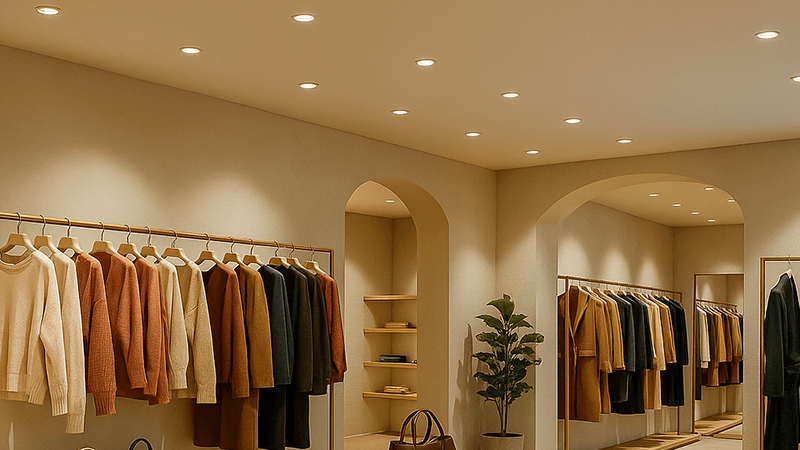
I’ve spent my career in the lighting industry, and I’ve seen many stores transform overnight with a simple lighting upgrade. It’s about more than just making a room bright. It’s about creating a feeling, telling a brand's story, and making your products look their absolute best. The technology behind this is more accessible than ever. Let's dig into how a small chip can make a huge difference in your retail chain1.
What are the benefits of COB LED?
Traditional LED setups often create harsh, multiple shadows2. This can make even premium products look cheap or flawed. COB LEDs solve this problem by providing a clean, single beam.
COB (Chip on Board) LEDs provide an intense, uniform light from a very compact source. This gets rid of ugly multiple shadows and offers excellent color rendering3. For a store, this means better-looking products, lower electricity bills4, and a more comfortable shopping environment.
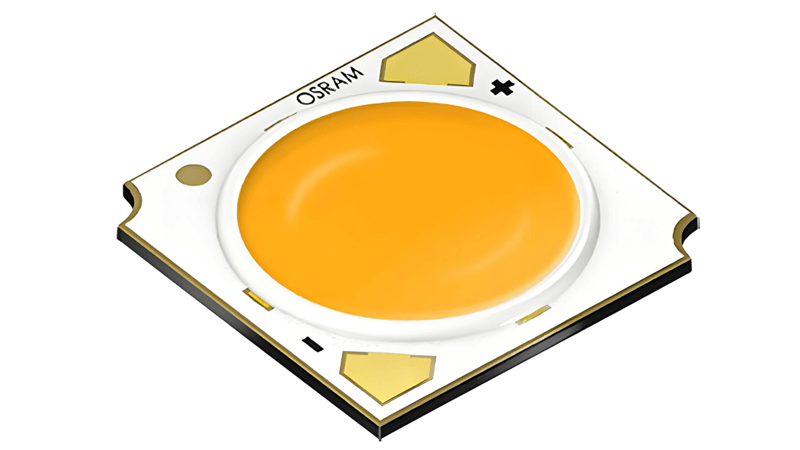
Deeper Dive: Why COB is a Game-Changer for Retail
When I started in this business, SMD (Surface Mounted Device) LEDs were the standard. They are small, individual lights placed on a circuit board. But COB technology changed everything by putting many tiny LED chips together on a single board. This creates what looks like one big, powerful light source.
The Power of a Single Light Source
Think about the sun. It’s a single, powerful light source. It creates a single, clean shadow. Now think about a fixture with many small, separate LEDs. Each one creates its own small shadow. When you use this to light a product, you get a messy, distracting pattern of multiple shadows. This can distort the shape and texture of an item. A COB LED acts like a classic halogen spotlight but without the heat and energy waste. It produces a single, crisp shadow, giving products a clean, high-end look. I remember a boutique client who sold textured handbags. Under their old SMD lights, the details were lost. After we installed COB downlights, the rich leather grain stood out, and they saw a direct increase in sales for those items.
Efficiency and Design Flexibility
COB LEDs are also very efficient. Because all the chips are on one substrate, they dissipate heat much better than individual SMD LEDs. Better heat management means a longer lifespan and more stable performance. This is critical for a purchasing manager like Shaz. Fewer replacements mean lower maintenance costs and less disruption to the store. Furthermore, their compact size gives designers more freedom. You can get a lot of light out of a very small fixture, allowing for a clean, minimalist ceiling design that keeps the focus on the merchandise, not on the lights themselves.
| Feature | COB LED | SMD LED |
|---|---|---|
| Light Appearance | Single, uniform beam | Multiple light points |
| Shadows | Single, clean shadow | Multiple, fuzzy shadows |
| Heat Dissipation | Excellent | Good |
| Best Application | Accent & directional lighting | General area lighting |
| Retail Impact | Creates focus, luxurious feel | Can feel flat or busy |
How can lighting be used to influence customer perception of a product?
You might have the best products in the world, but flat, poor-quality light makes them look average. This costs you sales every day. The right lighting reveals true color and texture.
Lighting directly shapes how customers see your products. High-quality COB LEDs with a high Color Rendering Index (CRI)5 make items look vibrant and true-to-life. Using focused light can also create a sense of luxury and guide attention to your most important products.
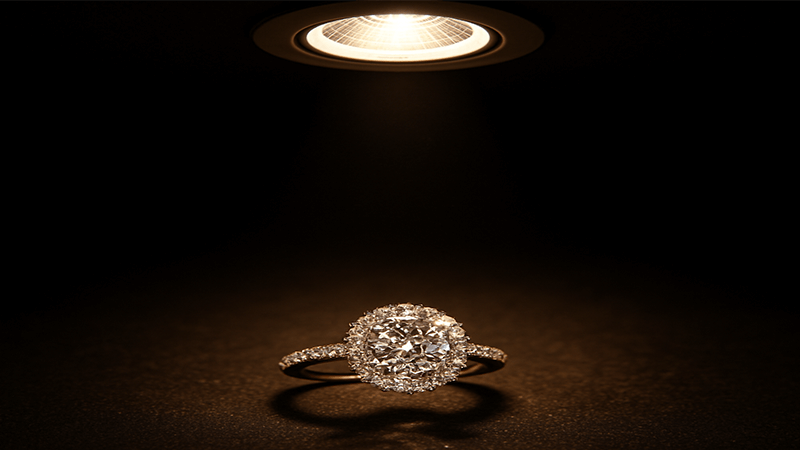
Deeper Dive: The Silent Salesman on Your Ceiling
Lighting speaks to your customers on a subconscious level. It tells them whether a product is premium, fresh, or worth a closer look. As manufacturers, we focus on the numbers behind this feeling, and two of the most important are CRI and R9.
The Critical Role of CRI and R9
CRI, or Color Rendering Index, measures how accurately a light source shows object colors compared to natural sunlight. The scale goes up to 100. For general use, a CRI of 80 is okay. But for high-end retail, I always tell my clients like Shaz that this is non-negotiable: you must use lights with a CRI of 90 or higher. Anything less, and colors will look washed out.
But CRI alone is not enough. You also need to look at R9. R9 is a specific score within the CRI measurement that represents how well the light renders deep red tones. This is incredibly important. So many products rely on rich reds—from fresh tomatoes in a grocery store to a red dress in a boutique or lipstick at a cosmetics counter. A light with a low R9 value6 (under 50) will make vibrant reds look dull and brownish. For any quality retail application, I strongly recommend a light source with R9 ≥50. This ensures all your product colors, especially the crucial reds, pop and look their best.
Creating Mood with Color Temperature
Beyond color accuracy, the color temperature7 (CCT) of the light sets the mood. It's measured in Kelvin (K).
| CCT Range | Feeling | Best For |
|---|---|---|
| 2700K - 3000K | Warm, cozy, intimate | Luxury boutiques, jewelry stores, restaurants |
| 3500K - 4000K | Neutral, clean, inviting | Fashion retail, showrooms, modern spaces |
| 5000K+ | Cool, bright, alert | Supermarkets (some areas), electronics stores |
A client of mine who owned a chain of high-fashion stores used 4000K light for years, thinking it made the store look clean. We tested a section with warmer 3000K COB spotlights. The atmosphere immediately felt more exclusive and luxurious. Customers spent more time in that section, and the perceived value of the clothing went up. They switched the entire chain over.
How does effective lighting impact store design?
You can have a brilliant store layout, but if the lighting is an afterthought, the space feels confusing. Customers get lost or miss entire sections. Lighting should be your guide.
Effective lighting is a fundamental part of store design8. It defines zones, creates clear pathways, and highlights architectural features. Good lighting can make a store feel larger or more intimate, supporting the overall design intent and reinforcing your brand identity.
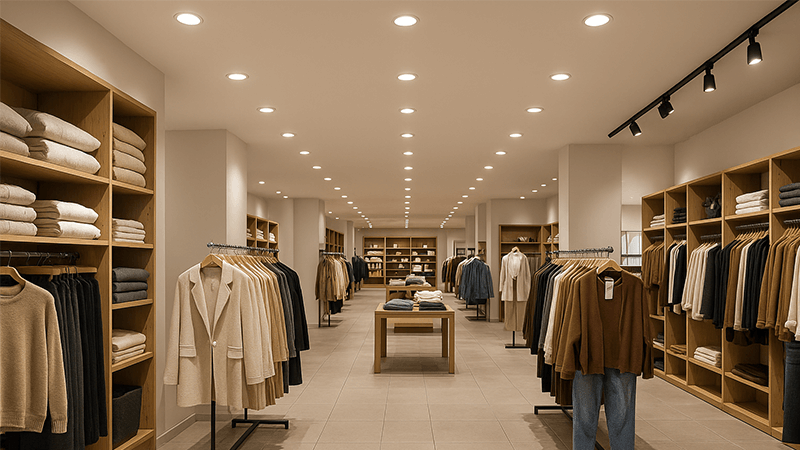
Deeper Dive: Lighting as an Architectural Tool
I often tell designers that light is another building material, just like wood or concrete. You can use it to build experiences and guide people through a space. In retail, this is achieved through a layered approach. It’s not just about one type of light; it’s about how different layers work together.
The Three Layers of Retail Lighting
- Ambient Lighting: This is the general, overall light that makes the store visible and safe. Recessed COB downlights are perfect for this. They provide a comfortable base layer of light without drawing attention to themselves. The goal is to make the entire space feel welcoming.
- Task Lighting: This is focused light for specific areas where customers or employees perform tasks, like at the checkout counter or in fitting rooms. Good task lighting9 in a fitting room is crucial—it must be flattering and render color accurately so customers feel confident in their choices.
- Accent Lighting: This is the star of the show. Accent lights, often adjustable COB track lights or spotlights, create drama and focus. You use them to highlight mannequins, feature walls, and high-margin products. By creating contrast—brightly lit products against a dimmer background—you tell customers exactly where to look. This layering creates a visual journey, pulling shoppers from one display to the next.
Enhancing the Space and Brand
Lighting also works with the physical space to reinforce your brand. For a brand that is all about natural, organic products, you might use lighting to highlight wood textures and create a warm, sunny feel. For a sleek, tech-focused brand, you would use clean, neutral light with sharp contrasts to create a futuristic and minimalist environment. A few years ago, we worked on a project for a shoe store with a beautiful exposed brick wall. It was a key part of their brand's urban identity, but it was lost in the shadows. We installed a series of COB wall-washer downlights. The light grazed down the wall, bringing out the rich texture of the brick. It became the store's main feature and a popular backdrop for customers' social media posts. The lighting didn't just light up a wall; it amplified the brand's story.
Why is lighting important in stores?
Too many retailers see lighting as a simple utility, like plumbing. This mindset leads to boring stores and missed opportunities. Good lighting is an active tool, a silent salesperson.
Lighting is vital in stores because it influences customer mood and behavior. It ensures products are seen clearly, enhances the brand image, and creates a comfortable atmosphere. Ultimately, a smart lighting strategy is a key driver of sales and customer loyalty.
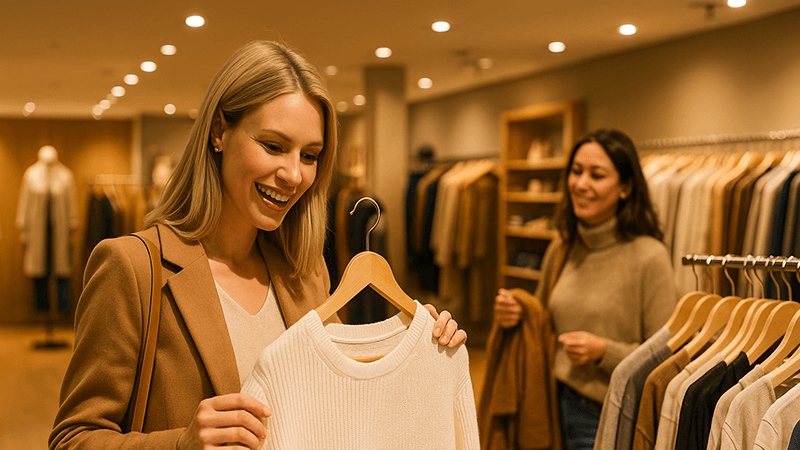
Deeper Dive: The Psychology and Profitability of Light
Everything we've discussed—the technology, the colors, the design—comes down to two things: how lighting makes people feel and how that feeling translates into sales. For a purchasing manager evaluating a lighting upgrade, this is the bottom line.
The Unseen Influence on Shoppers
The type and quality of light have a direct psychological impact. Bright, cool, uniform lighting, like that found in many big-box stores, can make people feel alert and focused on finding bargains quickly. It’s efficient but not very inviting. On the other hand, warmer light with pools of brightness and areas of soft shadow, found in luxury stores, encourages people to slow down. It creates a feeling of relaxation and discovery, which increases the amount of time they spend in the store. And we all know that the longer a customer stays, the more likely they are to buy. Light also builds trust. When lighting accurately shows the color and quality of a product, customers feel more confident in their purchase and are less likely to return it.
A Tangible Return on Investment
Investing in a quality COB LED lighting system is not an expense; it’s an investment with a clear return. First, there are the direct operational savings. COB LEDs are highly energy-efficient, which means lower electricity bills every month. They also have incredibly long lifespans, drastically reducing maintenance and replacement costs. I have clients who run their lights 12 hours a day and haven't had to change a bulb in over five years.
Second, and more importantly, is the impact on sales. Better product presentation from high-CRI lighting leads to higher conversion rates. A more pleasant and compelling store environment created by layered lighting10 design increases foot traffic and customer dwell time. It elevates your brand, allowing you to protect your margins and avoid competing solely on price. When you combine these revenue-generating benefits with the cost savings, the case for upgrading is clear. It’s one of the few improvements that positively impacts customer experience11, brand perception, and operating costs all at once.
Conclusion
In short, a great lighting strategy with high-quality COB LED downlights12 is not just a detail. It is a fundamental investment in your customer experience, your brand, and your success.
Discover the advantages of lighting upgrades for retail chains and their impact on sales and customer experience. ↩
Learn about the negative effects of multiple shadows on product presentation and customer perception. ↩
Explore the importance of color rendering in lighting and its effect on product appearance. ↩
Find out how energy-efficient COB LEDs can significantly reduce operational costs for retail businesses. ↩
Understand the importance of CRI in lighting choices and how it affects product visibility. ↩
Discover the significance of R9 value in lighting for accurately rendering deep red tones in products. ↩
Explore how different color temperatures can set the mood and enhance the shopping experience. ↩
Understand the critical role of lighting in shaping effective store design and customer flow. ↩
Discover the role of task lighting in enhancing customer experience and operational efficiency. ↩
Discover how a layered lighting approach can enhance the shopping experience and product visibility. ↩
Explore insights on how effective lighting can transform the shopping experience and increase customer satisfaction. ↩
Discover how COB LED downlights can enhance product visibility and boost sales in retail environments. ↩

